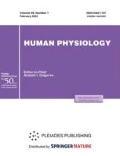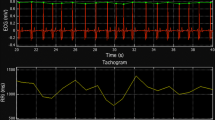Abstract
A new parameter, CS n (t) (CardStress), a quantitative characteristic of the changes in the cardiovascular regulatory mechanisms based on the relative decrease in the heart rate variability during a functional test, is proposed. Analysis of the heart rate variability was performed in patients exposed to non-steady-state (acutely increasing) normobaric hypoxic hypoxia induced by rebreathing. The new parameter was compared with traditional methods used to analyze tachograms (such as the windowed Fourier spectral transform and histograms).
Similar content being viewed by others
References
Gora, E.P., Vliyanie dykhaniya na funktsional’noe sostoyanie sistem organizma cheloveka (serdechno-sosudistuyu sistemu i TsNS) (The Influence of Respiration on the Functional State of Human Physiological Systems (Cardiovascular System and CNS), Moscow: Prometei, 1987.
Malkin, V.B. and Gora, E.P., Giperventilyatsiya (Hyperventilation), Moscow: Nauka, 1990.
Meerson, F.Z., Mechanisms of Adaptation to High-Altitude Hypoxia, in Itogi Nauki Tekh., Ser.: Fiziol. Chel. Zhiv., Moscow: Vses. Inst. Nauchn.-Tekh. Inf., 1974, vol. 14.
Chizhov, A.Ya. and Potievskaya, V.I., Preryvistaya normobaricheskaya gipoksiya v profilaktike i lechenii gipertonicheskoi bolezni (Intermittent Normobaric Hypoxia in the Prevention and Treatment of Hypertension), Moscow: RUDN, 2002.
Kiselev, A.R., Kirichuk, V.F., Posnenkova, O.M., and Gridnev, V.I., Mechanisms of Periodic Heart Rate Oscillations: A Study Using Controlled Breathing Tests, Fiziol. Chel., 2005, vol. 31, no. 3, p. 76 [Hum. Physiol. (Engl. Transl.), 2005, vol. 31, no. 3, p. 309].
Krivoshchekov, S.G., Divert, G.M., and Divert, V.E., Extension of the Functional Range of Respiratory and Gas Exchange Responses in Repetitive Hypoxia, Fiziol. Chel., 2005, vol. 31, no. 3, p. 100 [Hum. Physiol. (Engl. Transl.), 2005, vol. 31, no. 3, p. 330].
Leutin, V.P., Platonov, Ya.G., Divert, G.M., and Krivoshchekov, S.G., Changes in the Central Regulation of the Respiratory Function after a Single Session of Intermittent Normobaric Hypoxia, Fiziol. Chel., 2003, vol. 29, no. 1, p. 13 [Hum. Physiol. (Engl. Transl.), 2003, vol. 29, no. 1, p. 8].
Makarov, L.M., Kholterovskoe monitorirovanie (Holter Monitoring), Moscow: Medpraktika, 2003.
Soroko, S.I., Burykh, E.A., Bekshaev, S.S., and Sergeeva, E.G., Human Systemic Reactions to a Dosed Exposure to Hypoxia: A Multiparameter Study, Fiziol. Chel., 2005, vol. 31, no. 5, p. 88 [Hum. Physiol. (Engl. Transl.), 2005, vol. 31, no. 5, p. 573].
Lund, V.E., Kentala, E., Scheinin, H., et al., Heart Rate Variability in Healthy Volunteers during Normobaric and Hyperbaric Hyperoxia, Acta Physiol. Scand., 1999, vol. 167, no. 1, p. 29.
Bozhokin, S.V., Samoilov, V.O. and Shchenkova, I.M., Heart Rate Variability in Experimental Hypoxia, in Tez. IV Vses. Konf. “Mekhanizmy funktsionirovaniya vistseral’nukh sistem” (Abstracts IV All-Union Conference “Functional Mechanisms of the Visceral Systems”), St. Petersburg, 2005, p. 42.
Baevskii, R.M., Ivanov, G.G., Chireikin, L.V., et al., Analysis of the Heart Rate Variability with Various Cardiological Systems (Methodical Recommendations), Vestn. Aritmol., 2001, no. 24, p. 65.
Baevskii, R.M., Kirillov, O.I., and Kletskin, S.Z., Matematicheskii analiz serdechnogo ritma pri stresse (Mathematical Analysis of Cardiac Rhythm in Stress), Moscow: Nauka, 1984.
Bozhokin, S.V., Matematicheskoe opisanie serdechnogo ritma. Uchebnoe posobie (Mathematical Description of the Cardiac Rhythm: A Tutorial), St. Petersburg: Polytech. Univ., 2005.
Heart Rate Variability. Standards of Measurement, Physiological Interpretation, and Clinical Use. For Cardiologists, Functional Diagnosticians, Electrophysiologists, Teachers and Students of Medical Universities and Colleges. Task Force of the European Society of Cardiology and the North American Society of Pacing and Electrophysiology, St. Petersburg: INKART, 2000.
Mikhailov, V.M., Variabel’nost’ serdechnogo ritma: Opyt prakticheskogo primeneniya metoda (Heart Rate Variability: An Experience of Practical Use), Ivanovo: Ivanovo State Med. Akad., 2002.
Sobolev, A.V., The Problems of Quantitative Evaluation of the Heart Rate Variability in Holter Monitoring, Vestn. Aritmol., 2002, no. 26, p. 17.
Goldenberger, J., Challapalli, S., Tung, R., et al., Relationship of Heart Rate Variability to Parasympathetic Effect, Circulation, 2001, vol. 103, no. 15, p. 1977.
Malliani, A., The Pattern of Sympathovagal Balance Explored in Frequency Domain, News Physiol. Sci., 1999, vol. 14, p. 111.
Nolan, J., Batin, P.D., Andrews, R., et al., Prospective Study of Heart Rate Variability and Mortality in Chronic Heart Failure: Results of the United Kingdom Heart Rate Failure Evaluation and Assessment of Risk Trial (UK-Heart), Circulation, 1998, vol. 98, no. 15, p. 1510.
Kotel’nikov, S.A., Nozdrachev, A.D., Odinak, M.M., et al., Cardiac Rhythm Variability: Approaches to Mechanisms, Fiziol. Chel., 2002, vol. 28, no. 1, p. 130 [Hum. Physiol. (Engl. Transl.), 2002, vol. 28, no. 1, p. 114].
Nesterov, S.V., Autonomic Regulation of the Heart Rate in Humans under Conditions of Acute Experimental Hypoxia Fiziol. Chel., 2005, vol. 31, no. 1, p. 82 [Hum. Physiol. (Engl. Transl.), 2005, vol. 31, no. 1, p. 70].
Bernardi, L., Passino, C., and Wilmerding, V., Breathing Patterns and Cardiovascular Autonomic Modulation during Hypoxia Induced by Simulated Altitude, J. Hypertens., 2001, vol. 19, no. 5, p. 947.
Farinelli, C.C., Kayser, B., and Binzoni, T., Autonomic Nervous Control of Heart Rate at Altitude (5050 m). Eur. J. Appl. Physiol., 1994, vol. 69, no. 6, p. 502.
Hughson, R.L., Yamamoto, Y., and McCullough, R.E., Sympathetic and Parasympathetic Indicators of Heart Rate Control at Altitude Studied by Spectral Analysis, J. Appl. Physiol., 1994, vol. 77, p. 2537.
Perini, R., Milesi, S., Biancardi, L., and Veicsteinas, A., Effects of High Altitude Acclimatization on Heart Variability in Resting Humans, Eur. J. Appl. Physiol., 1996, vol. 73, no. 6, p. 521.
Author information
Authors and Affiliations
Additional information
Original Russian Text © S.V. Bozhokin, I.M. Shchenkova, 2008, published in Fiziologiya Cheloveka, 2008, Vol. 34, No. 4, pp. 80–87.
Rights and permissions
About this article
Cite this article
Bozhokin, S.V., Shchenkova, I.M. Analysis of the heart rate variability using stress tests. Hum Physiol 34, 461–467 (2008). https://doi.org/10.1134/S0362119708040105
Received:
Published:
Issue Date:
DOI: https://doi.org/10.1134/S0362119708040105




